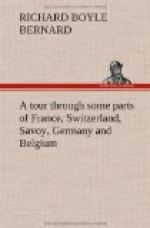Of all the Swiss towns this is considered as the most remarkable for the adoption of French fashions, and there is much more dissipation here than at Geneva, as it is the constant residence of many wealthy families; but, with few exceptions, the houses are neither large nor well built. Near the church is shewn the residence of Gibbon, the historian, and his library is now the property of a gentleman of this town, who purchased it in England.
Lausanne was formerly subject to its bishops, who were princes of the German Empire. A council was held here in 1448, when Pope Felix V., to restore peace to the Romish church, and extinguish the schisms to which it was then a prey, resigned the tiara and retired to the Abbey of Ripaille, in Savoy, a second time. This prince is distinguished by some of the historians of his century by the title of the Solomon of the age. He succeeded to the Dukedom of Savoy by the name of Amadeus VII., and having abdicated that sovereignty, retired to the abbey of Ripaille, which he had long admired as a secluded retreat, and to which he was a great benefactor. His restless disposition having induced him to seek the papal dignity, he, soon after obtaining it, became a second time a recluse but did not subject himself to any great mortification.
This remarkable character died in 1451, aet. 69, at Geneva; he was buried with a Bible under his head, with this inscription, the application of which, I do not exactly understand:
“La ville de Geneva est situee au milieu des montagnes; son territoire est sablonneux, tres-peu etendu, et les habitans sont curieux de nouveautes.” “The city of Geneva is situated amongst mountains, its territory is sandy, and of small extent, and its inhabitants are curious concerning novelty.”
The reformation was established in the Pays de Vaud, in 1536, after a public controversy had been held between the Protestant and Romish ecclesiastics. The environs of Lausanne present as cheerful and animated a sight as is to be seen in any part of Switzerland, and the view from the public walk, in particular, is enlivened by the bays and promontories, which diversify the sides of the lake.




